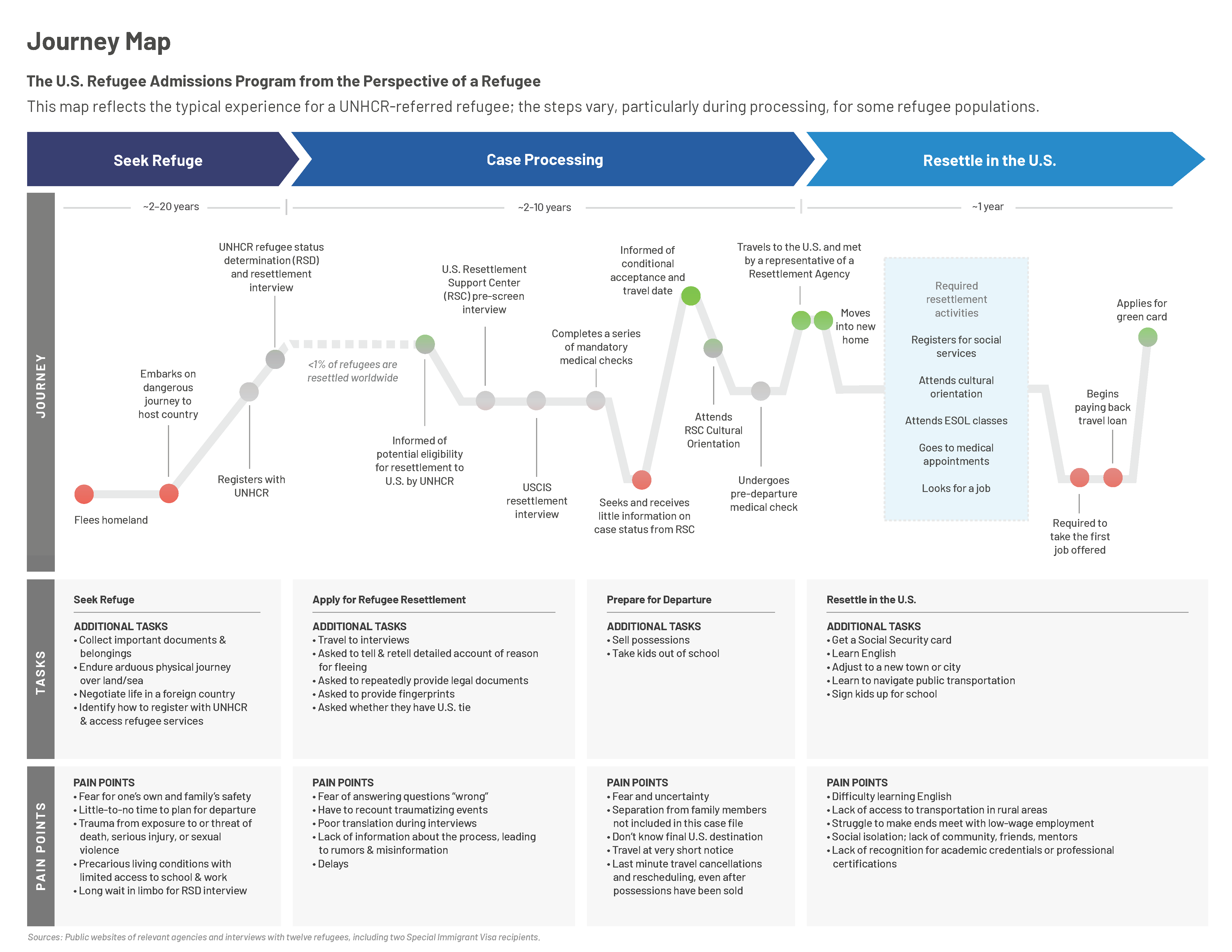Designing a roadmap to rebuild the U.S. Refugee Admission Program
Summary
If the new Biden Administration wanted to admit more refugees into the country and strengthen the program overall, they needed concrete recommendations on how to improve the U.S. Refugee Admissions Program (USRAP) and advance U.S. leadership in refugee protection around the world. Following user experience (UX) principles, we centered refugee voices in the project.

The challenge
When refugees come, they want to be self-sufficient. They are workers, they are doctors, they open businesses, they employ people. We pay taxes. Refugees and immigrants are the backbone of the economy of this country.
Refugee from Angola, resettled in 2015
Refugee admissions under the U.S. Refugee Admissions Program reached historic lows from 2016–2020. Over that period, programs that support refugees resettling in the U.S. were largely dismantled.
Drastic improvements to the overall refugee experience were needed to scale and strengthen USRAP. Overseas, refugees can wait years in refugee camps before entering USRAP. The living conditions are very difficult, can be dangerous, offer few opportunities to work, and supply limited access to medical care. While waiting to move forward in the process, refugees have very little information on the progress of their case. Their lives are in limbo for years, before being sent across the globe with a few weeks notice.
Refugees also face significant challenges when they arrive in the U.S. Unless they have a friend or family member in the U.S., they have no say in where they’re resettled. They receive minimal government support through resettlement agencies and, in most cases, have to fend for themselves a few months after relocating to the U.S. Other barriers — like culture shock, access to transportation and education, and medical and mental health issues — make navigating resettlement particularly difficult. As one interviewee who spoke perfect English and worked with the U.S. military in Iraq put it when she resettled here in 2013:
What was challenging when I first arrived? Everything.
In addition, many policymakers, and even some who work with refugees, don’t understand the full scope of the process to get to the U.S.
The solution
To help USRAP prepare to admit 125,000 refugees in FY2022 (up from 15,000 in 2020), our team, led by Ariana Berengaut, Director of the Penn Biden Center and Eric Hysen, senior fellow at the National Conference on Citizenship, took a human-centered design approach to formulating our recommendations. In dozens of video calls, we talked to experts responsible for shaping policy, implementing operations, or advocating for USRAP. We met with refugees who experienced the admissions process. Using trauma-informed interviewing techniques, we asked them to recount their experience so we might glean critical information on what would make the process easier for incoming refugees. We also reviewed publicly-available data to identify refugee populations, analyze processing barriers, and model the impact of proposed recommendations.
This approach took into account the needs, challenges, and opportunities of refugees and their families.
Out of this research, we created action plans with concrete 100-day, 1-year, and 2–4 year strategies for moving those plans forward.
To improve refugee outcomes, for instance, we recommended that USRAP:
- Make greater use of virtual interviews for follow-up interviews and for hard-to-reach refugee populations
- Prioritize the finalization of security checks for thousands of refugees who, after being interviewed, have been stuck in the pipeline for years
- Develop a refugee-informed algorithmic approach to determine where refugees are resettled in the U.S.
- Increase the scale and scope of resettlement support
- Include a broader set of interventions, such as guaranteeing six months of housing support to all refugees rather than tying it to employability or health conditions
- Allowing flexibility in funding to resettlement agencies and states to address diverse refugee needs
Often, policymakers only work on one aspect of the admissions process and lack an in-depth or nuanced view of other parts of the program. We made a journey map illustrating all steps and pain points along the way from the perspective of a refugee, something one person who’d worked on policy for years said they’d never seen before.

Source: Penn Biden Center/NCoC
The results
- Completed over 100 interviews with experts and stakeholders involved in shaping policy, implementing operations, or advocating for USRAP, as well as refugees who went through the process
- Helped write a 50-page report and complementary paper
- Created a journey map of the U.S. Refugee Admissions Program from the perspective of a refugee
- Two project leads were hired into the Biden Administration: Eric Hysen as Chief Information Officer at DHS and Ariana Berengaut as Senior Advisor to National Security Advisor, Jake Sullivan, giving the recommendations more hope of implementation